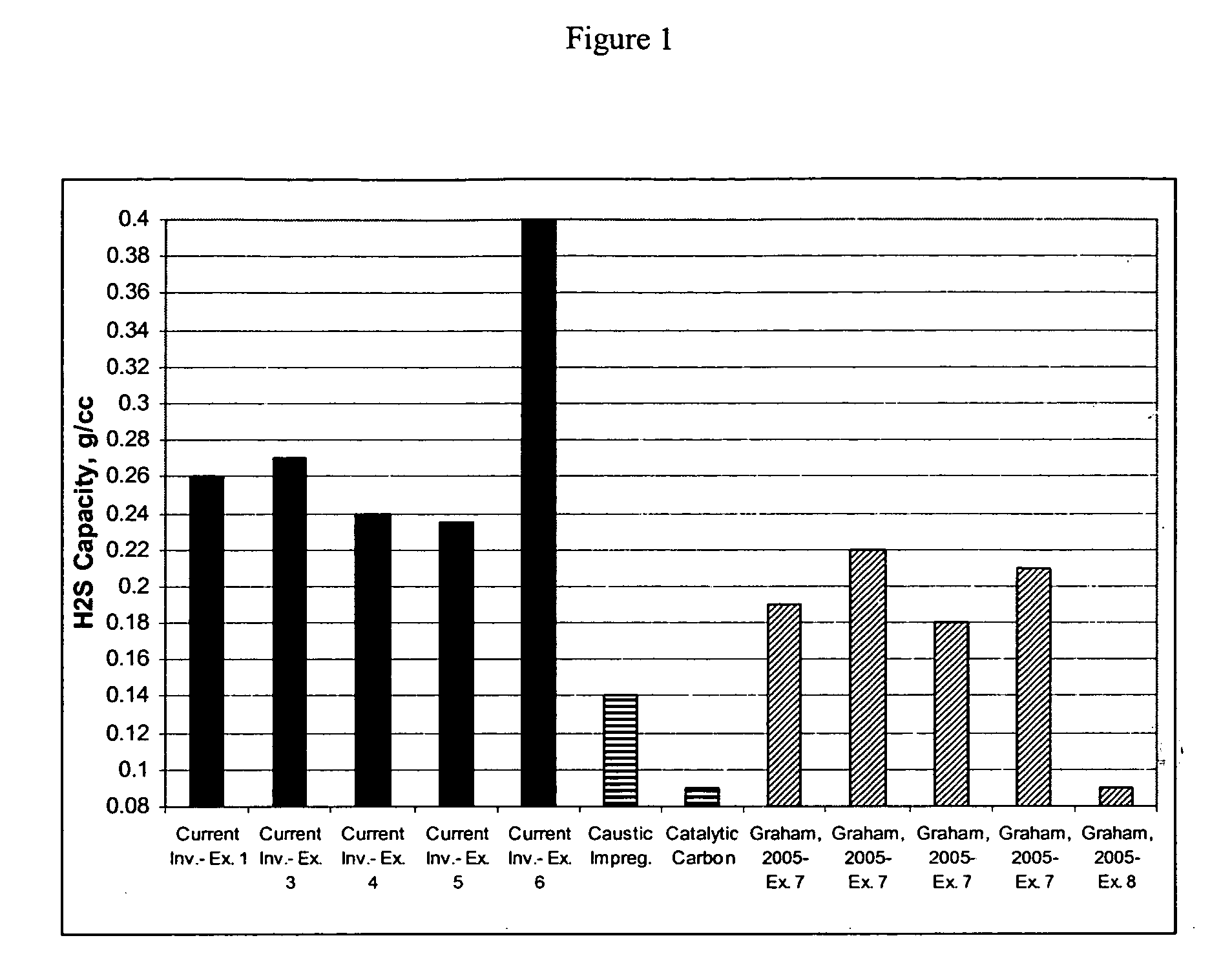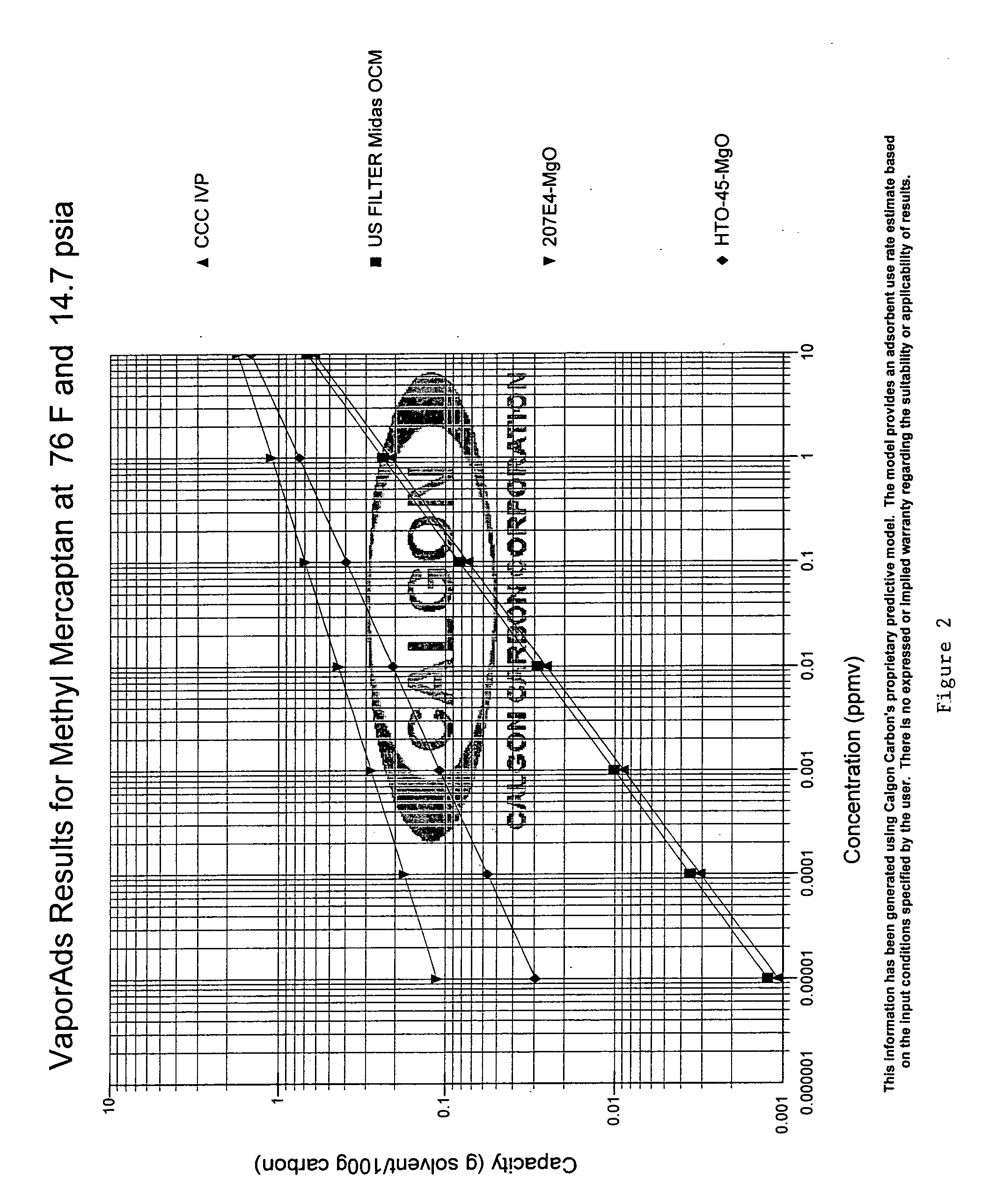Adsorbents for removing H2S, other odor causing compounds, and acid gases from gas streams and methods for producing and using these adsorbents
a technology of odor-causing compounds and adsorbents, which is applied in the direction of dispersed particle separation, chemistry apparatus and processes, and separation processes, etc., can solve the problems of limiting the economic viability of activated carbon, limiting the ability of caustic impregnated materials to achieve the effects of reducing the risk of odor, high kinetic rate of removal, and high capacity for compounds
- Summary
- Abstract
- Description
- Claims
- Application Information
AI Technical Summary
Benefits of technology
Problems solved by technology
Method used
Image
Examples
example 1
[0036] In an example, a pelletized activated carbon, WS-480 (Calgon Carbon Corp., Pittsburgh, Pa.) was used as the porous material. WS-480 had a nominal carbon tetrachloride activity of about 80% and nominal particle diameter of about 4 mm. A solution of magnesium acetate made from about 45 g of magnesium acetate tetrahydrate was sprayed over about 100 g of WS-480 activated carbon to primarily distribute the metal oxide on or over the surface of each pore of the porous media. The resulting carbon was just below the point of incipient wetness, that is, the pores of the carbon were filled with solution so that metal oxide was primarily distributed on or over the internal surface of the carbon, while there was little or no solution on the external surface of the carbon. The activated carbon having the magnesium acetate tetrahydrate primarily distributed on or over the surface of the pores was heat treated in a rotary kiln at 850° C. in a nitrogen atmosphere for 30 minutes. The resultan...
example 2
[0037] In another example, a solution of magnesium acetate tetrahydrate made from about 22 g of magnesium acetate tetrahydrate was sprayed onto about 100 g of WS-480 activated carbon to primarily distribute the metal salt solution on or over the surface of the pores of the carbon, as described in Example 1, above. The activated carbon having the magnesium acetate tetrahydrate primarily distributed on or over the surface of the pores was heat treated in a rotary kiln at 800° C. in a nitrogen atmosphere for 30 minutes. The resultant carbon adsorbent had about 2.5 g Mg per 100 g carbon, with Mg present as MgO, and an H2S capacity of about 0.21 g / cc. Thus, the carbon adsorbent manufactured by the method of manufacture of the present invention yields an adsorbent having an H2S capacity that is higher than that of caustic-impregnated and catalytic carbons previously known in the art and currently used in commercial odor control applications, while only requiring about half of the magnesiu...
example 3
[0038] In yet another example, a pelletized activated carbon, 207E4 (Calgon Carbon, Columbus, Ohio) was used as the porous material. The 207E4 carbon had a nominal carbon tetrachloride activity of about 70% and a particle diameter of about 4 mm. The metal salt used was Calcium Magnesium Acetate (CMA) (Cryotech Corp.), a mixture of calcium acetate and magnesium acetate (in about a 3:7 Ca:Mg molar ratio). The CMA solution was sprayed onto the 207E4 carbon. After the CMA solution was primarily distributed on or over the surface of each of the pores of the porous media, the carbon was heat treated at 850° C. in a steam atmosphere for 30 minutes to convert the magnesium salts to oxides and to additionally activate the carbon by reaction with steam by heating the carbon to above 800° C. in the presence of steam. As discussed above, steam was used to exclude oxygen, substantially preventing the activated carbon from burning, and also increasing the pore volume of the carbon. The resultant ...
PUM
| Property | Measurement | Unit |
|---|---|---|
| Fraction | aaaaa | aaaaa |
| Fraction | aaaaa | aaaaa |
| Weight | aaaaa | aaaaa |
Abstract
Description
Claims
Application Information
 Login to View More
Login to View More - R&D
- Intellectual Property
- Life Sciences
- Materials
- Tech Scout
- Unparalleled Data Quality
- Higher Quality Content
- 60% Fewer Hallucinations
Browse by: Latest US Patents, China's latest patents, Technical Efficacy Thesaurus, Application Domain, Technology Topic, Popular Technical Reports.
© 2025 PatSnap. All rights reserved.Legal|Privacy policy|Modern Slavery Act Transparency Statement|Sitemap|About US| Contact US: help@patsnap.com


